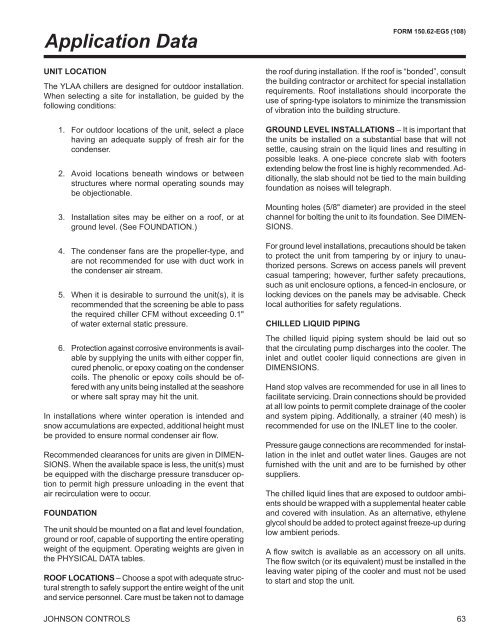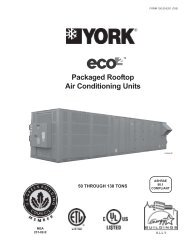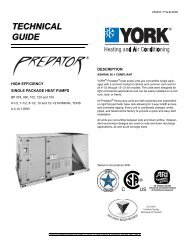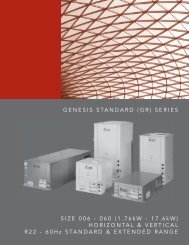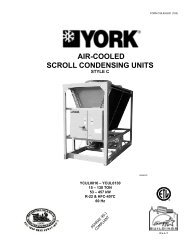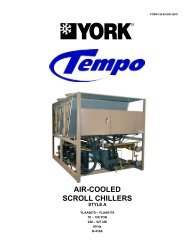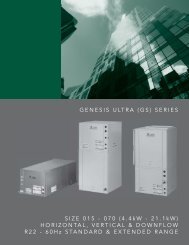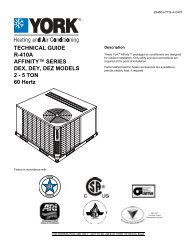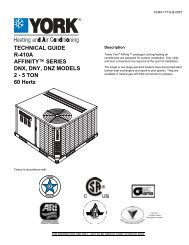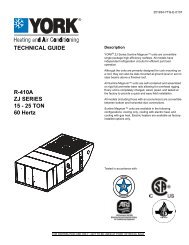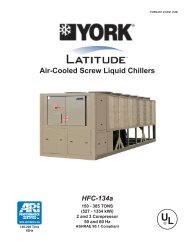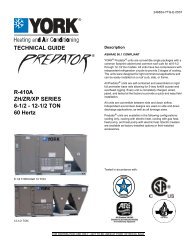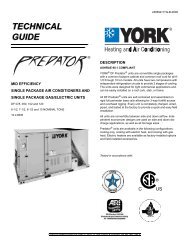YLAA - HVAC Tech Support
YLAA - HVAC Tech Support
YLAA - HVAC Tech Support
You also want an ePaper? Increase the reach of your titles
YUMPU automatically turns print PDFs into web optimized ePapers that Google loves.
Application Data<br />
FORM 150.62-EG5 (108)<br />
Unit Location<br />
The <strong>YLAA</strong> chillers are designed for outdoor installation.<br />
When selecting a site for installation, be guided by the<br />
following conditions:<br />
1. For outdoor locations of the unit, select a place<br />
having an adequate supply of fresh air for the<br />
condenser.<br />
2. Avoid locations beneath windows or between<br />
structures where normal operating sounds may<br />
be objectionable.<br />
3. Installation sites may be either on a roof, or at<br />
ground level. (See FOUNDATION.)<br />
4. The condenser fans are the propeller-type, and<br />
are not recommended for use with duct work in<br />
the condenser air stream.<br />
5. When it is desirable to surround the unit(s), it is<br />
recommended that the screening be able to pass<br />
the required chiller CFM without exceeding 0.1"<br />
of water external static pressure.<br />
6. Protection against corrosive environments is available<br />
by supplying the units with either copper fin,<br />
cured phenolic, or epoxy coating on the condenser<br />
coils. The phenolic or epoxy coils should be offered<br />
with any units being installed at the seashore<br />
or where salt spray may hit the unit.<br />
In installations where winter operation is intended and<br />
snow accumulations are expected, additional height must<br />
be provided to ensure normal condenser air flow.<br />
Recommended clearances for units are given in Dimensions.<br />
When the available space is less, the unit(s) must<br />
be equipped with the discharge pressure transducer option<br />
to permit high pressure unloading in the event that<br />
air recirculation were to occur.<br />
Foundation<br />
The unit should be mounted on a flat and level foundation,<br />
ground or roof, capable of supporting the entire operating<br />
weight of the equipment. Operating weights are given in<br />
the PHYSICAL DATA tables.<br />
ROOF LOCATIONS – Choose a spot with adequate structural<br />
strength to safely support the entire weight of the unit<br />
and service personnel. Care must be taken not to damage<br />
jOHNSON CONTROLS<br />
the roof during installation. If the roof is “bonded”, consult<br />
the building contractor or architect for special installation<br />
requirements. Roof installations should incorporate the<br />
use of spring-type isolators to minimize the transmission<br />
of vibration into the building structure.<br />
GROUND LEVEL INSTALLATIONS – It is important that<br />
the units be installed on a substantial base that will not<br />
settle, causing strain on the liquid lines and resulting in<br />
possible leaks. A one-piece concrete slab with footers<br />
extending below the frost line is highly recommended. Additionally,<br />
the slab should not be tied to the main building<br />
foundation as noises will telegraph.<br />
Mounting holes (5/8" diameter) are provided in the steel<br />
channel for bolting the unit to its foundation. See DIMEN-<br />
SIONS.<br />
For ground level installations, precautions should be taken<br />
to protect the unit from tampering by or injury to unauthorized<br />
persons. Screws on access panels will prevent<br />
casual tampering; however, further safety precautions,<br />
such as unit enclosure options, a fenced-in enclosure, or<br />
locking devices on the panels may be advisable. Check<br />
local authorities for safety regulations.<br />
Chilled Liquid Piping<br />
The chilled liquid piping system should be laid out so<br />
that the circulating pump discharges into the cooler. The<br />
inlet and outlet cooler liquid connections are given in<br />
DIMENSIONS.<br />
Hand stop valves are recommended for use in all lines to<br />
facilitate servicing. Drain connections should be provided<br />
at all low points to permit complete drainage of the cooler<br />
and system piping. Additionally, a strainer (40 mesh) is<br />
recommended for use on the INLET line to the cooler.<br />
Pressure gauge connections are recommended for installation<br />
in the inlet and outlet water lines. Gauges are not<br />
furnished with the unit and are to be furnished by other<br />
suppliers.<br />
The chilled liquid lines that are exposed to outdoor ambients<br />
should be wrapped with a supplemental heater cable<br />
and covered with insulation. As an alternative, ethylene<br />
glycol should be added to protect against freeze-up during<br />
low ambient periods.<br />
A flow switch is available as an accessory on all units.<br />
The flow switch (or its equivalent) must be installed in the<br />
leaving water piping of the cooler and must not be used<br />
to start and stop the unit.<br />
63


